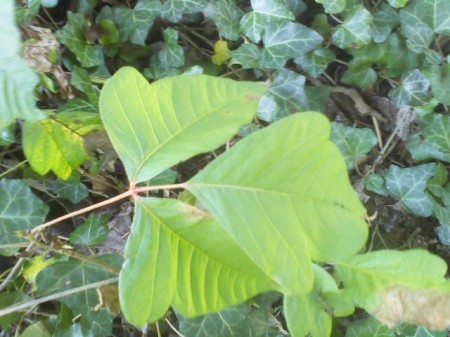Poison Ivy is the Worst Weed
From the Norris NPR interview of Dr. Lewis Ziska, plant physiologist for the USDA:
Many people are allergic to poison ivy, a vine with triple leaf clusters.
“Even if you barely brush up against it, you can get an angry, weeping, contagious, red rash that takes weeks to heal. Well, it turns out that poison ivy, along with its voracious cousins poison oak and poison sumac, is even more of a nuisance this summer. The plants are spreading faster, growing larger, showing up in new places and becoming more toxic. It’s the kind of thing that’s so scary, it almost deserves its own soundtrack.”
So why is Poison Ivy the worst weed in 2010?
“One of the things that we think is occurring is that as carbon dioxide is increasing in the atmosphere. Carbon Dioxide is a basic greenhouse gas, but it’s also plant food. And plants take that carbon, and they convert it into sugars and carbohydrates and so forth.
“But not all plants respond the same way to that resource, and we think that vines, particularly vines like poison ivy or kudzu or other noxious weeds, seem to show a much stronger response to the change in CO2 than other plant species. So on average, the poison ivy plant of 1901, can grow up to 60 percent larger as of 2010 just from the change in CO2 alone, all other things being equal.
“And as a result of that change, we see not only more growth but also a more virulent form of the oil within poison ivy. The oil is called urushiol, and it’s that oil that causes that causes that rash to occur on your skin…”
*
Unfortunately, pulling poison ivy (if you are not allergic) often breaks the vine off above ground, and leaves the root system underground. This is like the Sorcerer’s Apprentice chopping the mops in half, and they multiply like a hydra head. So as much as an organic gardener hates to admit it, poisoning poison ivy is the best way to fight it. Just one problem: Poisons do not work very well either. Here are some photos of Poison Ivy after using 2 different brands of “Poison Ivy Herbicide” after 2 weeks. While dumping the herbicides on the areas will kill everything there, you can see here a few squirts of poison sometimes barely wilts the leaves, even when there is no rain.

 note: Poison Ivy is the vine with 3 leaves, below on the ground is common English Ivy
note: Poison Ivy is the vine with 3 leaves, below on the ground is common English Ivy
Although I have mercy on most other wild plants that people call weeds, I have no mercy on poison ivy because my mother is very allergic to it. Poison Ivy threats to take over as many gardens as it can get itself into, and after years of killing it, it has remained in the same area for over 40 years. Somewhere underground, there must be a mother root of poison ivy continuously sending out branches. Crabgrass and Wisteria are the same way; there seems to be no way to stop them from coming back within a 40 foot area. If you have any success stories, please post them below!
*
Top Five Worst Weeds (not useful or harmful)
1. Poison Ivy
2. Crab Grass
3. Wisteria & Kudzu (aesthetic but strong, fast growing and extremely destructive vines)
4. English Ivy, Virginia Creeper, Honey Suckle (aesthetic but damaging vines)
5. Thistles, Briers, Burrs
Top Five Best Weeds (useful as food for humans and bees)
1. Lambs Quarters
2. Dandelions
3. Clovers
4. Mints
5. Wild Spinaches, Mustards, Flowers, etc…
